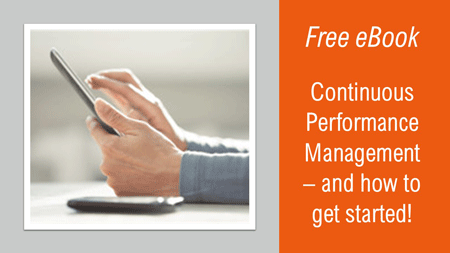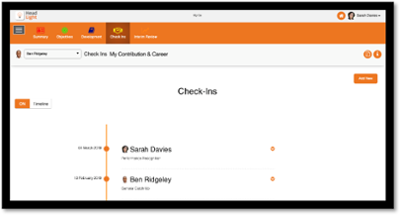How Head Light supports police forces with requirements of the NTDS
Back in January, the College of Policing announced its National Talent Development Strategy (NTDS) t...
It is well documented that over the last three to four years there has been a movement away from a traditional annual, ratings-based performance appraisal process. The current direction of travel is towards a more agile, conversation-based and individual approach to managing performance, also known as Continuous Performance Management (CPM). This movement is picking up speed: 79% of executives rate it a high priority, up from 71% three years ago, with 38% calling the movement “very important.” (Deloitte University Press)
However, change is rarely straightforward. Many of the processes and systems that HR has built over the years revolve around those performance ratings. A key question for many HR professionals we work with is; how can organisations - built on a bonus culture or expectation, drive their employee reward strategy, without the bedrock of detailed statistics and ratings from annual performance appraisal discussions?
Clearly reward strategy must take into account employee performance. It is fair for exceptional performers to be recognised for their success and there should be motivators for individuals to achieve their objectives. However, it is equally important that performance management discussions are open and honest to ensure that conversations reflect a true performance picture and required development goals.
The driver for change
At Head Light we believe that Performance Management should not be a compliance exercise but a tool to proactively drive positive change & growth within the business. Sadly, a body of research has proven that the time, money and effort spent on traditional appraisal processes didn’t actually achieve what it was intended to - ultimately improve performance. Research by Adobe found that their previous annual performance review process (besides the maintenance of the complex infrastructure) required 80,000 hours of time from 2000 managers, which equals the full-time work of 40 employees. In 2015, Deloitte found itself spending two million hours a year rating every employee’s performance and potential, collating those ratings, discussing and calibrating them. It also realised that the end results were not particularly accurate, meaning all that time and effort was achieving very little. These discoveries provided the incentive for change and thankfully they pioneered another way.
What is Continuous Performance Management?
Continuous Performance Management is the practice of having regular, on-going, one-to-one performance conversations between a manager and team member throughout the year.
As such and by definition, a Continuous Performance Management approach is one which is:
Ultimately, it’s about driving regular performance conversations and not driving performance ratings and measures.
Performance Conversations v Performance Measures

With CPM there is a shift in focus from quantitative to qualitative data gathering. Through capturing the outcomes of ongoing performance discussions, a large amount of authentic evidence can be gathered, equipping a line manager to more effectively track the ongoing performance and achievements of the members of their team. What this also means is that a rich body of evidence is available to enable a line manager to confidently contribute to any merit-based reward discussions without needing to utilise scales which has proven to over-complicate reward process.
In fact, 91% of companies that have adopted continuous performance management say that they now have better data for people decisions. **
It is unlikely that performance conversations will be fruitful, honest and transparent if individuals experience a discussion about pay and bonus at the same time as they are discussing performance. It is for this reason that performance conversations should be detached from performance measurement discussions, particularly for the purpose of determining rewards.
Rewarding Performance within a CPM model
CPM-based performance metrics are not based upon one (perhaps biased) view, but one which takes account of a wide range of data on employee performance, and which incorporates self-assessment, client/customer feedback, 360 degree reviews, crowd-sourced feedback and other performance metrics to help people determine progress and achievement.
Through commentary from organisations such as Deloitte, Accenture, Adobe, Microsoft and Gap, who all advocate a CPM-based approach we have seen a number of different ways organisations are seeking to translate that into a decision on employee reward.
A trend in all of these approaches is an increased reliance on the role of the manager to review the data and provide a judgement for a performance-related pay decision. Effective management training in this area is crucial for success but in reality, is this an effective route to determine pay? Does this not leave the reward process open to bias? Many organisations have researched this including Intel, Juniper Systems and Cargill where, supervisors had no difficulty allocating merit-based pay without appraisal scores. In fact, both line managers and HR staff felt that paying closer attention to employee performance throughout the year was likely to make their merit-pay decisions more valid.
Deloitte asks immediate team leaders to evaluate the data provided by the continuous review process to determine their future intentions with team members instead of their skills. So instead of rating employees as part of an annual appraisal, Deloitte’s managers now answer questions about each of their team members each quarter, one of which is “Given what I know of this person’s performance, and if it were my money, would I award this person the highest possible compensation increase and bonus?”
In Accenture’s CPM review process the annual review and stack rankings were replacement with ongoing feedback from managers to reports. Managers also do a check-in, a structured conversation between managers and direct reports to touch base on goal progress, development or competencies, at the end of a project. Reward continues to be influenced by an evaluation of performance and is to be decided by the manager.
KPMG has also implemented CPM, focusing on providing regular feedback and debriefing to staff for every major assignment with the goal to encourage a collaborative work culture through qualitative discussions. They also introduced a steeper bonus curve for its highest performing staff. What is evident in this period of change, is there is no ‘one size fits all’ approach to how and if you should use CPM as a tool to support your employee reward strategy. What is clear however is that communication, training managers on the skills to provide feedback and coaching for positive performance, employee engagement and a company culture that supports open and honest performance discussions is key to success. As each organisation is unique, performance management and reward strategies need to be tailored to the needs of the business and ultimately be about positively influencing both business and employee impact and growth.
Key Findings:
To help you decide where you need to focus attention, we've created an eBook to offer some background and give some practical next steps to consider.

Get the eBook now and you'll learn in more depth:
Want to take a 'sneak peek' at how Check-Ins can be done on-line? Take a couple of minutes and watch the video below:

You'll want to explore the software more, and see it for yourself, so, when you're ready, get in touch and let's arrange a time to take you through it. If you are ready to start the conversation right now, then get in touch.
Regards
The Head Light team
** Rock et al., Is transforming performance management worth it? View in article
Examples:
KPMG
https://www.consultancy.uk/news/1285/kpmg-pilots-alternative-to-bell-curve-evaluation-system
Accenture overview
Back in January, the College of Policing announced its National Talent Development Strategy (NTDS) t...
The growing external pressures on fire and rescue services are vast, with increasing operational dem...
Employee engagement is about how enthusiastic and connected people feel about where they work. It go...